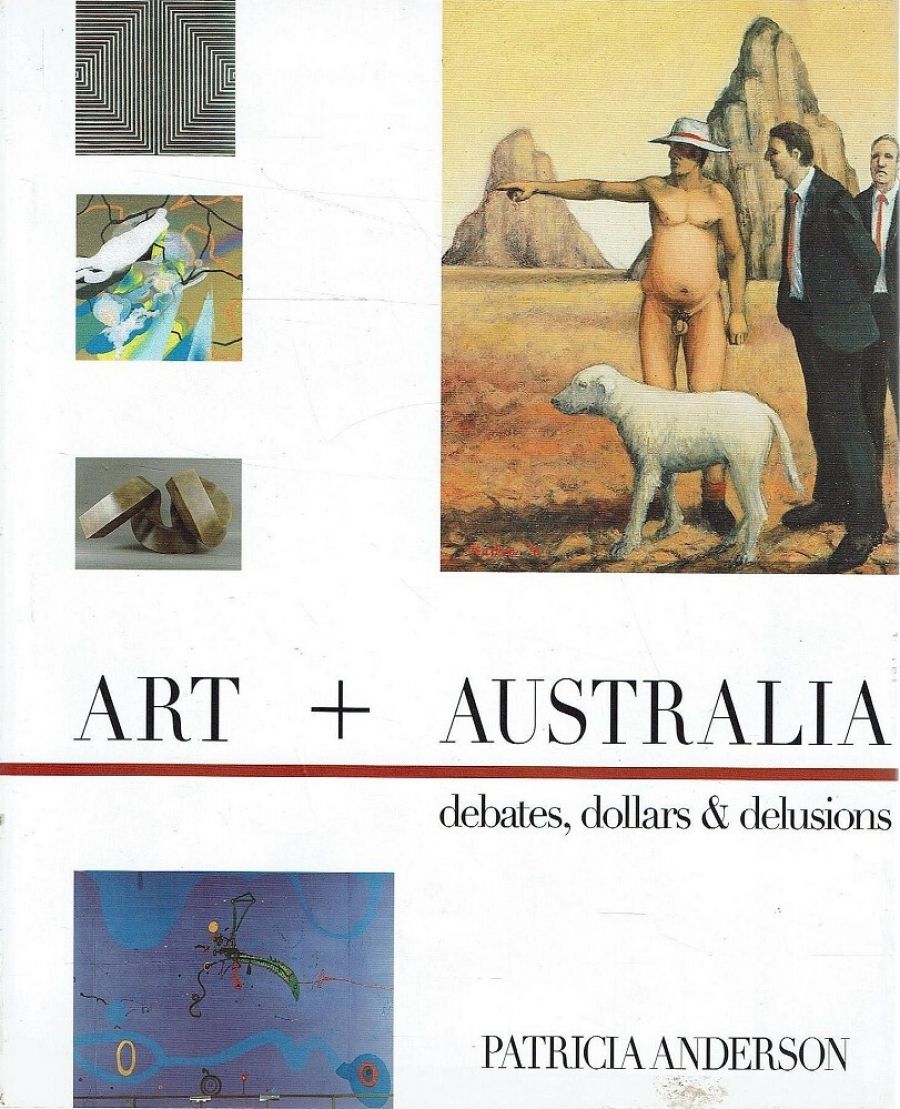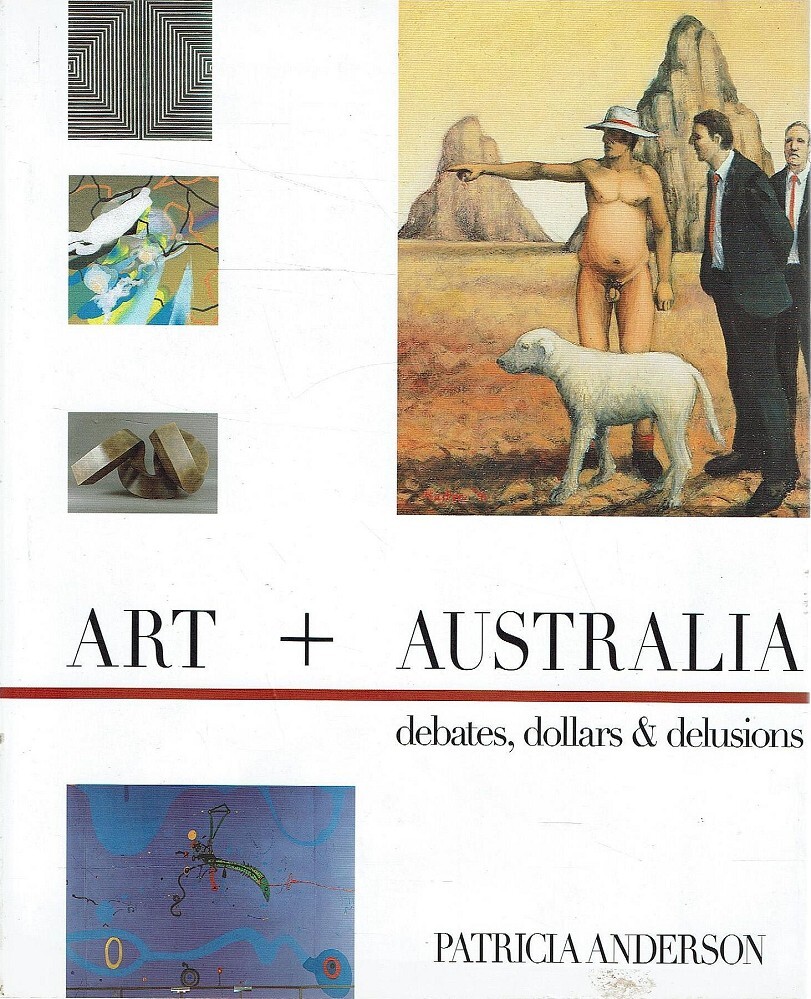
- Free Article: No
- Contents Category: Art
- Review Article: Yes
- Article Title: Click go the turnstiles
- Online Only: No
- Custom Highlight Text:
Art research is an absorbing occupation, not for the faint-hearted. The researcher must brave airless libraries, wrestle with gigantic volumes of old clippings from The Bulletin or the National Times, and listen to ubiquitous taped artist interviews by Hazel de Berg, all the while perched on precarious stools and suffering under low-wattage globes.
- Book 1 Title: Art + Australia
- Book 1 Subtitle: Debates, dollars & delusions
- Book 1 Biblio: Pandora Press, $59.95 pb, 619 pp
- Book 1 Cover Small (400 x 600):

- Book 1 Cover (800 x 1200):

Patricia Anderson, author of the self-published Art + Australia: Debates, Dollars and Delusions, is a tireless art researcher. This is evident in the 1484 reference endnotes, mainly newspaper clippings and catalogues, in the back of her new book. It is a reflection of how much time and energy she has given to her project. The author’s previous book, Elwyn Lynn’s Art World, was published in 2002 under her own imprint, Pandora Press, despite a professional disagreement with the late Lynn’s widow, who retracted copyright permission for the reproduction of images.
Anderson approaches, with an engaging and intelligent voice, her new subject matter, which covers more than a century of Australian art: the market place, university courses, arts funding and Aboriginal art, to name just a few of her sub-topics. This is apparent in her discussion of nude paintings in the chapter, ‘Thanks for the Mammary – Nude, Naked or Just Undressed’: ‘These were a genre plumped with the exotic splendours of the middle eastern world – harem pictures if you like – which allowed the chaps to do their own variety of armchair travelling without ever leaving their antimacassared chairs or their aspidistras unwatered.’
The author muses over the challenges of abstract art in a chapter entitled ‘The Unbearable Brightness of Seeing’, and charts the role of constructivist artists in Sydney in ‘Chicken Wire and Parachute Silk’. These titles reveal a playful approach. Two of the most successful chapters follow the critical dramas and melodramas of author and art reviewer Robert Hughes, and the benevolent and philanthropic deeds of expatriate collector John Power. Both characters have had a profound influence on Australian art and are worthy of attention.
So where will Anderson’s latest tome sit, with its expansive title? Will it lean against Bernard Smith’s Australian Painting 1788–1990 (1992) or snuggle up to Andrew Sayers’ Australian Art (2001)? Perhaps not, for it is less about art than about the art players: collectors, dealers, gallery directors and artists. Quotations from luminaries are heavily relied upon, but are generally second-hand. In her many endnotes, Anderson cites only five people she has spoken with in direct interviews. Rex Irwin, Philip Bacon and Chris Deutscher are quoted as believing fellow dealer Denis Savill to be a great guy. This mutual backslapping is hardly surprising; perhaps the author wishes to present a flip side to the cliché of ‘dealer as evil money-maker’, but why not interview these men directly so that the quotes are not removed from their original context?
In his book The Sweeper-up after Artists (2003), the noted New York art writer Irving Sandler records an anecdotal history of art, life and debates between artists Willem de Kooning, Mark Rothko, Ad Reinhardt, Barnett Newman and others. He also recalls the vitriolic critical warfare between Harold Rosenberg and Clement Greenberg, as he experienced it. Sandler’s quotes are mostly sourced from conversations – directly with the artists. He also invites the reader into New York life during the 1940s to 1960s. Anderson’s book lacks the same immediacy and intimacy, and would have benefited from a similar approach.
In the Australian art world, writers and academics are encouraged to pursue an area of expertise. It doesn’t matter if the specialisation is rococo dog paintings or contemporary Chinese documentary installation art, as long as it is focused and discriminating. Whilst this may initially seem élitist, there is sound reasoning behind it: art curators, writers and lecturers know a lot about a little, rather than the reverse.
In this new book, Anderson covers a lot of ground: benefactions, Australian modernism, women artists (mention of Nancy Borlase is a worthy inclusion), collectors, fakes, new artists as careerists, portraiture (not the old Archibald again) and more. The author says in her foreword: ‘each chapter is self-contained so that the reader can begin anywhere and move backwards and forwards as the mood dictates.’ However, a defining argument that linked the essays would have provided a more sound structure.
‘Click Go the Turnstiles, Click Click Click’ is a chapter that leaves the reader slightly bemused. Anderson’s text swoops from overbearing museum guides to gallery funding to directors. From there, she moves to gallery architecture to attendance figures to blockbuster exhibitions to extension plans to collecting policies, and, finally, to curatorial trends – all in less than sixteen pages. No single point is developed fully which suggests a lack of theoretical or thematic discipline. Could good editing be one of the casualties of self-publishing?
In her newspaper and art journal articles, Patricia Anderson has proven herself a succinct and intelligent writer with clear opinions. In her new book, which exceeds 600 pages, she takes a more meandering approach. Nevertheless, if the author is able to avoid ‘photocopier’s curse’, a malaise common to research addicts, then we will no doubt be reading more by her hand.


Comments powered by CComment